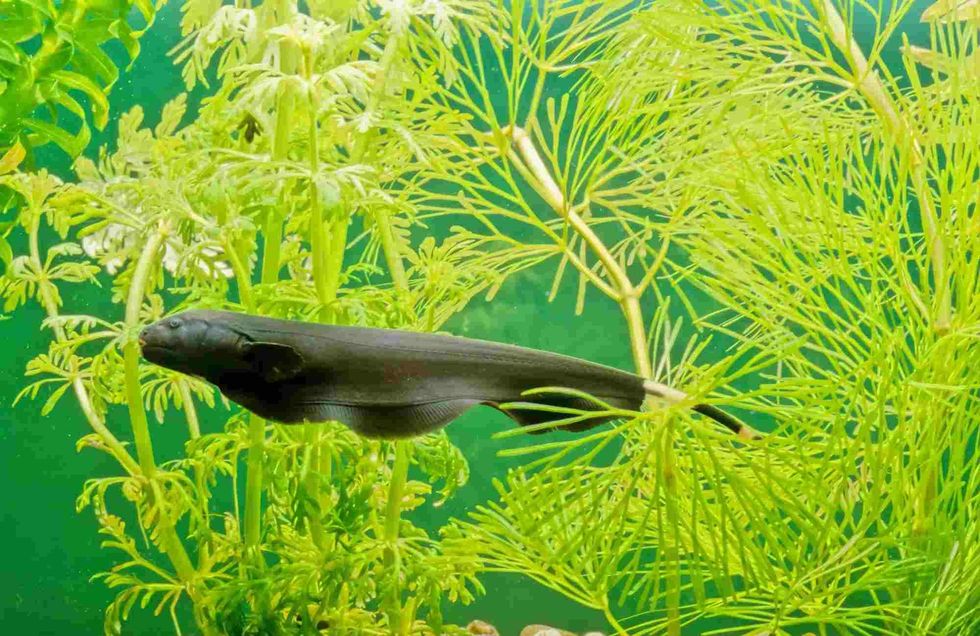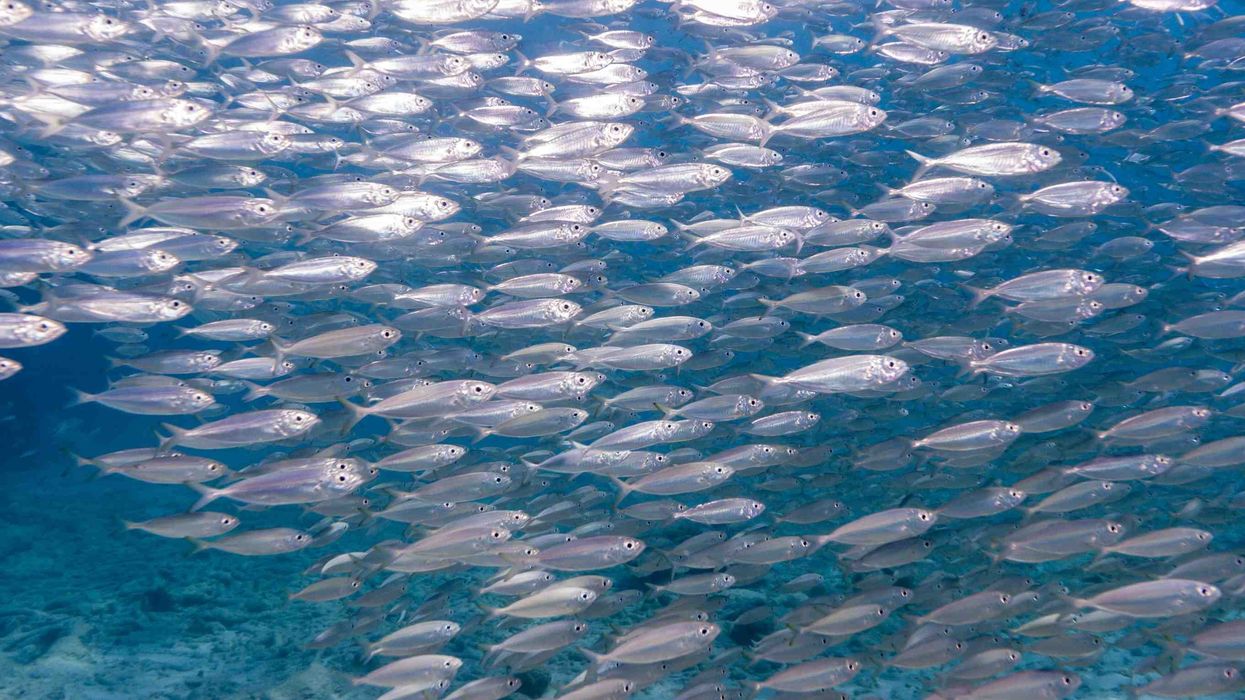Ghost knifefish belong to the family of Apteronotidae (ray-finned fishes), of the order Gymnotiformes. These fish belong to South American ranges and Panama.
They occupy a broad range of habitats with freshwater. More than 50% of the species of the family are located very deep in rivers, deeper than 16 ft (5 m), where there is very little light. Many of these species are very aggressive predators of fish and tiny aquatic insects' larvae.
The black ghost knifefish (Apteronotus albifrons) is a tropical fish that belongs to the ghost knifefish family. Black ghost knifefish are nocturnal in nature. They are weakly electric-powered fish that use an electric-powered organ and receptors dispensed over the duration in their body that allows it to find insect larvae.
If you like these, then you should definitely read our articles on lanternfish and milkfish.
Knifefish Interesting Facts
What type of animal is a knifefish?
A knifefish (Gymnotiformes) consists of, at most, approximately 50 species of Central and South American fishes located in quiet lagoons and lakes. They are positioned in three families: Gymnotidae (regularly referred to as gymnotid eels), Apteronotidae, and Rhamphichthyidae.
What class of animal does a knifefish belong to?
Knifefish (Apteronotus albifrons) are a species of black nocturnal fish, a native of South America, that belongs to the animal's Actinopterygii class.
How many knifefish are there in the world?
The exact population of the black ghost knifefish (Apteronotus albifrons) is unknown, but it is considered to be Least Concern. They are common and preserved in the wildlife aquarium.
Where does a knifefish live?
Knifefish (Gymnotiformes) are a species of fish that originate in freshwater habitats in South America. Starting from Venezuela, they swim to the Paraguay-Paraná River, which includes the Amazon Basin. They are famous for being kept in an aquarium. The black ghost knifefish (Apteronotus albifrons) natively lives in rapidly moving, sandy floor creeks in a tropical climate.
What is a knifefish's habitat?
The black ghost knifefish (Apteronotus albifrons) inhabit several habitats within the wild, consisting of lakes and big rivers. Several species flow into flooded forests during the moist seasons to breed. While most species inhabit a quiet water habitat with considerable vegetation, glass knives decide upon deep river channels with robust currents.
Who do knifefish live with?
Black ghost knifefish are especially stored with tank associates that aren't too boisterous or aggressive. Discus, angelfish, severum, non-violent catfish, non-violent cichlids, and larger community species of fishes make appropriate tankmates. In the wild, they stay in groups of the same family.
How long does a knifefish live?
The black ghost knife fish are nocturnal aquatic fish that live for 10-15 years in the water and the aquarium.
How do they reproduce?
Very little is understood about the breeding of this fish. The tank-bred population is bred in ponds in Indonesia. Due to the massive length of the adults, breeding could require an exceptionally enormous aquarium.
It isn't always viable to reproduce these fish without confined ponds or aquariums. However, it is possible. The black ghost knife fish have a far better chance of successful breeding if they are bred in a non-threatening environment.
The female will no longer lay eggs if she doesn't sense security inside the aquarium. Ponds had been said to have a far better achievement rate of inbreeding. However, ponds make it very hard to manipulate the young ones and gather the eggs.
Black ghost knifefish (Apteronotus albifrons) have little attachment to their very own young or eggs in the wild and could conveniently devour their own spawn.
What is their conservation status?
The conservation status of the black ghost knife fish (Apteronotus albifrons) that prey on fish deep in the water is Least Concern as per the IUCN Red List.
Knifefish Fun Facts
What does knifefish look like?

The black ghost knifefish (Apteronotus albifrons), as their name implies, is completely black with two white rings on the tail and a stripe of white on its nostril that frequently extends alongside its back. Unsurprisingly, it's also in the form of a knife; it has no caudal or dorsal fin.
Their body is flat and elongated, achieving up to 20 in (51 cm) in length when grown. The anal fin stretches alongside the frame from the stomach to the tail. This offers it a stylish forward swimming style.
How cute are they?
The black ghost knifefish is not that cute to look at but is still quite a sight. It is kept in an aquarium for people to look at and admire the fish. Some people even play with them in the aquarium as these fish can be tamed.
How do they communicate?
Black ghost knifefish (Apteronotus albifrons) can each emit and obtain electric-powered signals called electronic organ discharge. The power is produced by an organ found near the tail. These cells are at the pores and skin of the fish and are used for each communication and electrolocation.
How big is a knifefish?
The black ghost knifefish can grow up to 12-47 in (31-120 cm) in length. The knifefish is ten times bigger than the sea slugs.
How fast can a knifefish swim?
The black ghost knifefish have been known to reach speeds of 5.5 mph (9 kph).
How much does a knifefish weigh?
Knifefish weigh 1-26.8 lb (0.5-12 kg).
What are the male and female names of the species?
There are no different names given to the male and female knifefish.
What would you call a baby knifefish?
Baby knifefish is often called the young knifefish or fry.
What do they eat?
Knifefish are carnivorous fishes. In the wild, they feed on juveniles, insect larvae, and small fish and worms. In an aquarium, this won't alternate a great deal, and they need to be fed with clean or frozen meals together with bloodworms, blackworms, or brine shrimps.
Are they dangerous?
However, this fish interacts well with other large species of a non-violent nature but can be competitive toward the ones of comparable or smaller size and predators.
Would they make a good pet?
Once aware of its surroundings, the black ghost knifefish can be extraordinarily tamed and even handheld. These fish readily accept any type of food, so you need not be picky with food brands. Just feed them worms, meat, or flaked food.
The ghost knifefish can grow to the maximum length of 20 in (51 cm).
Did you know...
The electronic organ discharge (EOD) produced by a knifefish can be used to differentiate among varieties of weakly electric powered fish, i.e., the pulse-kind and the wave-kind. The black ghost knifefish are said to be of the latter kind because they could constantly generate EOD in small intervals.
By emitting its personal non-stop train of EODs, the fish can decide the presence of close-by items with the aid of using sensing perturbations in timing and amplitude of electrical fields - a capacity referred to as lively electrolocation.
Can you eat knifefish?
Fishers in Florida are very interested in clown knifefish for the game than for food. However, it is safe to eat and has plenty of industrial prices within the nations found locally in Thailand, Vietnam, Cambodia, and Laos. People consume the flesh of this fish minced, cooked with curry, and rolled into balls.
Here at Kidadl, we have carefully created lots of interesting family-friendly animal facts for everyone to discover! Learn more about some other fish from our pilchard facts and John Dory facts pages.
You can even occupy yourself at home by coloring in one of our free printable knifefish coloring pages.










